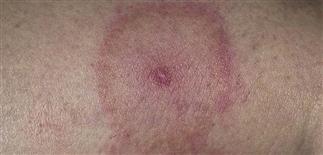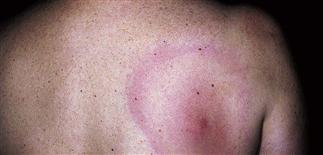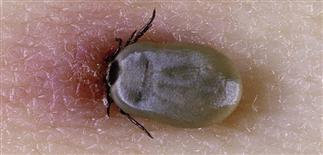95
Lyme disease

Large 5-cm targetoid patch with central clearing, bright-red expanding border and central bite inflammation, characteristic of the erythema migrans rash of Lyme disease.

Erythema migrans. ‘Bull’s-eye’ lesion. Bright-red or pink expanding circulate patch with central clearing. Bite mark is usually centrally located.

Multiple inflamed expanding erythematous patches, with central bluish hue characteristic of disseminated Lyme disease.

Embedded engorged tick.
DESCRIPTION
Tick-borne disease caused by spirochete Borrelia burgdorferi. Has three stages. Can affect multiple organ system. Cutaneous eruption called erythema migrans. In Europe, other species of Borrelia also cause Lyme like-disease. The ‘black-legged’ tick or Ixodes species (I. scapularis and I. pacificus) are the ticks responsible for transmitting Lyme disease in the USA.
HISTORY
Like syphilis, Lyme disease affects many organs, occurs in stages, and mimics other diseases. Disease onset is 3–28 days after infective tick bite. Stages may overlap or occur alone. • Stage 1: expanding target-like patch (erythema migrans) and influenza-like symptoms, including fever, headache, arthralgias. • Stage 2: cardiac, neurologic symptoms. • Stage 3: arthritis present, neurologic problems persist.
PHYSICAL FINDINGS
• Initial tick bite causes local inflamed bite reaction. Bite may be painless. Tick must stay attached for at least 24 h for infection to occur. • Skin changes, erythema migrans the most characteristic, not present in all cases. • Erythema migrans is a bright-red, edematous, expanding eruption at site of inoculation. Begins as small papule or patch with enlarging ring if erythema. Central erythema gradually fades, leaving a flesh-colored to light blue surface, rarely vesicular. Erythematous patch remains flat, blanches with pressure. May reach up to >10 cm in diameter. Expanding border of erythema migrans may be slightly raised. Many patients (20–50%) have multiple concentric rings at sites of subsequent hematogenous dissemination. Erythema migrans lesions usually fade within 3–4 weeks, even if untreated. • Results of serologic testing for anti-Borrelia antibodies by enzyme-linked immunosorbent assay (ELISA) are positive at initial presentation in 25% of infected patients, and positive in 75% of them 4–6 weeks later, even with antibiotic therapy. More specific Western immunoblot test used to corroborate equivocal or positive results obtained with ELISA.
TREATMENT
• Preventing tick bites is first line of defense. Wear protective garments, tuck pants into socks, wear closed-toed shoes. DEET can be used on skin, or permethrin (Permanone) on clothing. • Check to detect ticks after hiking or yard work and remove ticks as soon as possible. • Adults with early Lyme disease should receive 21 days of treatment with doxycycline (100 mg b.i.d.), amoxicillin (500 mg t.i.d.), or cefuroxime axetil (Ceftin) (500 mg b.i.d.). Amoxicillin (25–50 mg/kg t.i.d.) or cefuroxime axetil (250 mg b.i.d.) used for children under 8 years old. • Disease that has progressed to stage 2 or 3 requires more intensive treatment. IV ceftriaxone 2 g q.d. for 14 days for advanced Lyme meningitis and neurologic disease. • The prophylactic antibiotic treatment of tick bites is common but controversial. A single dose of doxycycline 200 mg, has been advocated by some. In most circumstances, treating a person for tick bite alone is not recommended.







